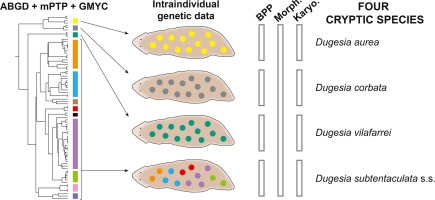当前位置:
X-MOL 学术
›
Mol. Phylogenet. Evol.
›
论文详情
Our official English website, www.x-mol.net, welcomes your
feedback! (Note: you will need to create a separate account there.)
Cryptic species delineation in freshwater planarians of the genus Dugesia (Platyhelminthes, Tricladida): Extreme intraindividual genetic diversity, morphological stasis, and karyological variability.
Molecular Phylogenetics and Evolution ( IF 3.6 ) Pub Date : 2019-05-28 , DOI: 10.1016/j.ympev.2019.05.010 Laia Leria 1 , Miquel Vila-Farré 2 , Marta Álvarez-Presas 1 , Alejandro Sánchez-Gracia 1 , Julio Rozas 1 , Ronald Sluys 3 , Marta Riutort 1
Molecular Phylogenetics and Evolution ( IF 3.6 ) Pub Date : 2019-05-28 , DOI: 10.1016/j.ympev.2019.05.010 Laia Leria 1 , Miquel Vila-Farré 2 , Marta Álvarez-Presas 1 , Alejandro Sánchez-Gracia 1 , Julio Rozas 1 , Ronald Sluys 3 , Marta Riutort 1
Affiliation

|
The keystone of planarian taxonomy traditionally has been the anatomy of the copulatory apparatus. However, many planarian species comprise asexual fissiparous populations, with the fissiparous animals not developing a copulatory apparatus, thus precluding their morphological identification. Incorporation of molecular data into planarian systematics has been of great value, not only in the identification of fissiparous individuals but also as an additional source of information for determining species boundaries. Nevertheless, the discrepancy between morphological and molecular data has highlighted the need for extra sources of taxonomic information. Moreover, a recent study has pointed out that fissiparous reproduction may lead to high levels of intraindividual genetic diversity in planarians, which may mislead molecular analyses. In the present study we aim to test a new up-to-date integrative taxonomic procedure for planarians, including intraindividual genetic data and additional sources of taxonomic information, besides morphology and DNA, using Dugesia subtentaculata sensu lato as a model organism, a species with an intricate taxonomic history. First, we used three different methods for molecular species delimitation on single locus datasets, both with and without intraindividual information, for formulating Primary Species Hypotheses (PSHs). Subsequently, Secondary Species Hypotheses (SSHs) were formulated on the basis of three types of information: (1) a coalescent-based species delimitation method applied to multilocus data, (2) morphology of the copulatory apparatus, and (3) karyological metrics. This resulted in the delimitation of four morphologically cryptic species within the nominal species D. subtentaculata. Our results provide evidence that the analysis of intraindividual genetic data is essential for properly developing PSHs in planarians. Our study reveals also that karyological differentiation, rather than morphological differentiation, may play an important role in speciation processes in planarians, thus suggesting that the currently known diversity of the group could be highly underestimated.
中文翻译:

Dugesia(Platyhelminthes,Tricladida)属淡水平面动物中的隐性物种划分:极端个体内的遗传多样性,形态停滞和核型变异性。
过去,平面学家分类学的重点是交配设备的解剖学。然而,许多平面动物物种包括无性的有鳍的种群,而有鳍的动物没有发育出交配器,因此排除了它们的形态学鉴定。将分子数据纳入涡虫系统学中,不仅在识别有裂生个体中具有重要价值,而且还可以作为确定物种边界的附加信息来源。尽管如此,形态学和分子数据之间的差异突出显示了对分类信息的额外来源的需求。此外,最近的一项研究指出,有胎生殖可能会导致涡虫中个体内遗传多样性的高水平,这可能会误导分子分析。在本研究中,我们旨在测试一种新的针对平面虫的综合分类学程序,其中包括形态学和DNA以外的个体遗传数据和分类学信息的其他来源,并使用Dugesia subtentaculata sensu lato作为模型生物,该种具有复杂的分类学历史。首先,我们使用三种不同的方法对单个基因座数据集进行分子物种定界,包括和不包含个体内信息,以制定主要物种假说(PSH)。随后,根据三种类型的信息制定了二级物种假说(SSH):( 1)一种基于聚结的物种定界方法应用于多基因座数据;(2)交配仪器的形态;(3)核数学指标。这导致在名义物种D. subtentaculata中划定了四个形态学上隐秘的物种。我们的结果提供了证据,对个体内遗传数据的分析对于正确开发涡虫中的PSH是必不可少的。我们的研究还表明,在涡虫的物种形成过程中,分类学而不是形态学的差异可能起重要作用,因此表明该群体目前已知的多样性可能被低估了。
更新日期:2019-11-18
中文翻译:

Dugesia(Platyhelminthes,Tricladida)属淡水平面动物中的隐性物种划分:极端个体内的遗传多样性,形态停滞和核型变异性。
过去,平面学家分类学的重点是交配设备的解剖学。然而,许多平面动物物种包括无性的有鳍的种群,而有鳍的动物没有发育出交配器,因此排除了它们的形态学鉴定。将分子数据纳入涡虫系统学中,不仅在识别有裂生个体中具有重要价值,而且还可以作为确定物种边界的附加信息来源。尽管如此,形态学和分子数据之间的差异突出显示了对分类信息的额外来源的需求。此外,最近的一项研究指出,有胎生殖可能会导致涡虫中个体内遗传多样性的高水平,这可能会误导分子分析。在本研究中,我们旨在测试一种新的针对平面虫的综合分类学程序,其中包括形态学和DNA以外的个体遗传数据和分类学信息的其他来源,并使用Dugesia subtentaculata sensu lato作为模型生物,该种具有复杂的分类学历史。首先,我们使用三种不同的方法对单个基因座数据集进行分子物种定界,包括和不包含个体内信息,以制定主要物种假说(PSH)。随后,根据三种类型的信息制定了二级物种假说(SSH):( 1)一种基于聚结的物种定界方法应用于多基因座数据;(2)交配仪器的形态;(3)核数学指标。这导致在名义物种D. subtentaculata中划定了四个形态学上隐秘的物种。我们的结果提供了证据,对个体内遗传数据的分析对于正确开发涡虫中的PSH是必不可少的。我们的研究还表明,在涡虫的物种形成过程中,分类学而不是形态学的差异可能起重要作用,因此表明该群体目前已知的多样性可能被低估了。







































 京公网安备 11010802027423号
京公网安备 11010802027423号